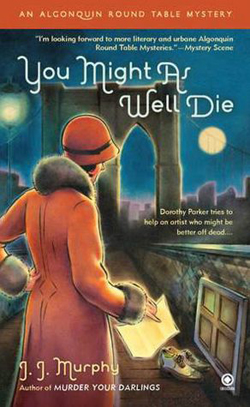 I confess – after I’ve closed the cover on a book, the details don’t stay with me for all that long. After a month or so has passed, I’ve probably forgotten all but the broadest strokes of the plot, and I likely couldn’t tell you who died or whodunit if you put a gun to my head.
I confess – after I’ve closed the cover on a book, the details don’t stay with me for all that long. After a month or so has passed, I’ve probably forgotten all but the broadest strokes of the plot, and I likely couldn’t tell you who died or whodunit if you put a gun to my head.
One thing I do tend to remember, however, is a strong sense of atmosphere. For me, there are some books that take place in a world so fully realized that I actually grow nostalgic for it when I’m away; I find myself hankering to be surrounded by its sights, scents, sounds, and people.
Author J.J. Murphy created such a place when he wrote his first Algonquin Round Table Mystery, Murder Your Darlings, and I’ve been itching for a return visit ever since. And now, thanks to the December release of Murphy’s latest, You Might as Well Die, I finally have my wish.
You Might as Well Die takes place in the gritty, witty, debaucherous world of Dorothy Parker’s New York—a New York of Automats and aristocrats, speakeasies and bathtub gin, where at any given moment you might find Harry Houdini disappearing a horse during an NFL halftime show or Harpo Marx and Alexander Woollcott playing their own unique brand of croquet down a busy city street.
Murphy employs a lot of different tactics to bring his fictional universe to life on the page. For one, his imagery is striking, and he frequently uses his descriptions to not only establish place and time, but mood, as well. Take, for example, this scene on the Brooklyn Bridge. Dorothy has just discovered an artist’s intent to commit suicide by jumping off the bridge at midnight. She races to the scene to try and stop him, but upon arriving, police in tow, finds nothing but the man’s shoes and one of his paintings:
“Now,” the detective said, turning back toward them and addressing Officer Compson, “what do we have here?”
Dorothy glanced over the handrail at the inky rippling water of the East River more than a hundred feet below. Then she looked across to the buildings that lined the Brooklyn side of the river. They were lit as if in miniature, like an elaborate toy train setup in a darkened room. She saw a factory with an illuminated clock, which read ten minutes after midnight.
“Well?” O’Rannigan barked.
“Forget it,” Dorothy said. “It’s water under the bridge.”
He also makes sure to show you his world through all of Dorothy’s senses, making for a fully immersive reading experience:
Moments later, Dorothy and Benchley were back on the sidewalk. The early-autumn afternoon was bright and sunny as they strolled along. The warm sunshine came at an angle, lighting the busy street with a golden glow. The air, which usually smelled of car exhaust and horse droppings, was now fragranced with a whiff of chimney smoke. A spinning cluster of dried leaves, animated by a cool breeze, danced across their path. Dorothy parted the dust devil of brown leaves with her little scuffed shoe.
But perhaps my favorite trick of Murphy’s is the way he uses cameo appearances of legendary figures to provide context and to add texture and magic his tale:
The next night, Halloween night, Houdini stood onstage, waved his hands, and opened the giant box. The crowd gasped. The five-ton elephant was gone.
Dorothy sat in the third row of the massive Hippodrome auditorium. She could feel the air being sucked past her as the five thousand people in the audience simultaneously drew in their breath.
Then, like the rest of the crowd, Dorothy applauded and cheered. The sound was thunderous. She automatically looked to her right, as she usually did when attending shows, to smile in mutual approval at the merry face of Benchley.
But Benchley wasn’t there, of course. The seat was empty.
In the hands of a lesser author, such stunt-casting might seem gratuitous, but Murphy deploys these appearances to brilliant effect; they lend his tales that certain je ne sais quoi I’m always looking for when I crack the cover of a book, and ultimately, they’re the thing that will always keep me coming back to Dorothy Parker and the Algonquin Round Table.
J. J. Murphy’s You Might as Well Die will be released on December 6. In the meantime, you can read my full rave review over at The Maine Suspect.

Hey, that’s my New York you are talking about–the one I was born too late to live in!! At least I got to love the Automat as a kid. Anway, I am going to give this book a try because you describe it as hitting the high notes and I can’t afford to miss that. Thanks .
I feel the same way!
The first book in the series is fabulous, too, and spends a lot of time in the Algonquin and in Tony Soma’s speakeasy. Definitely give it a try!